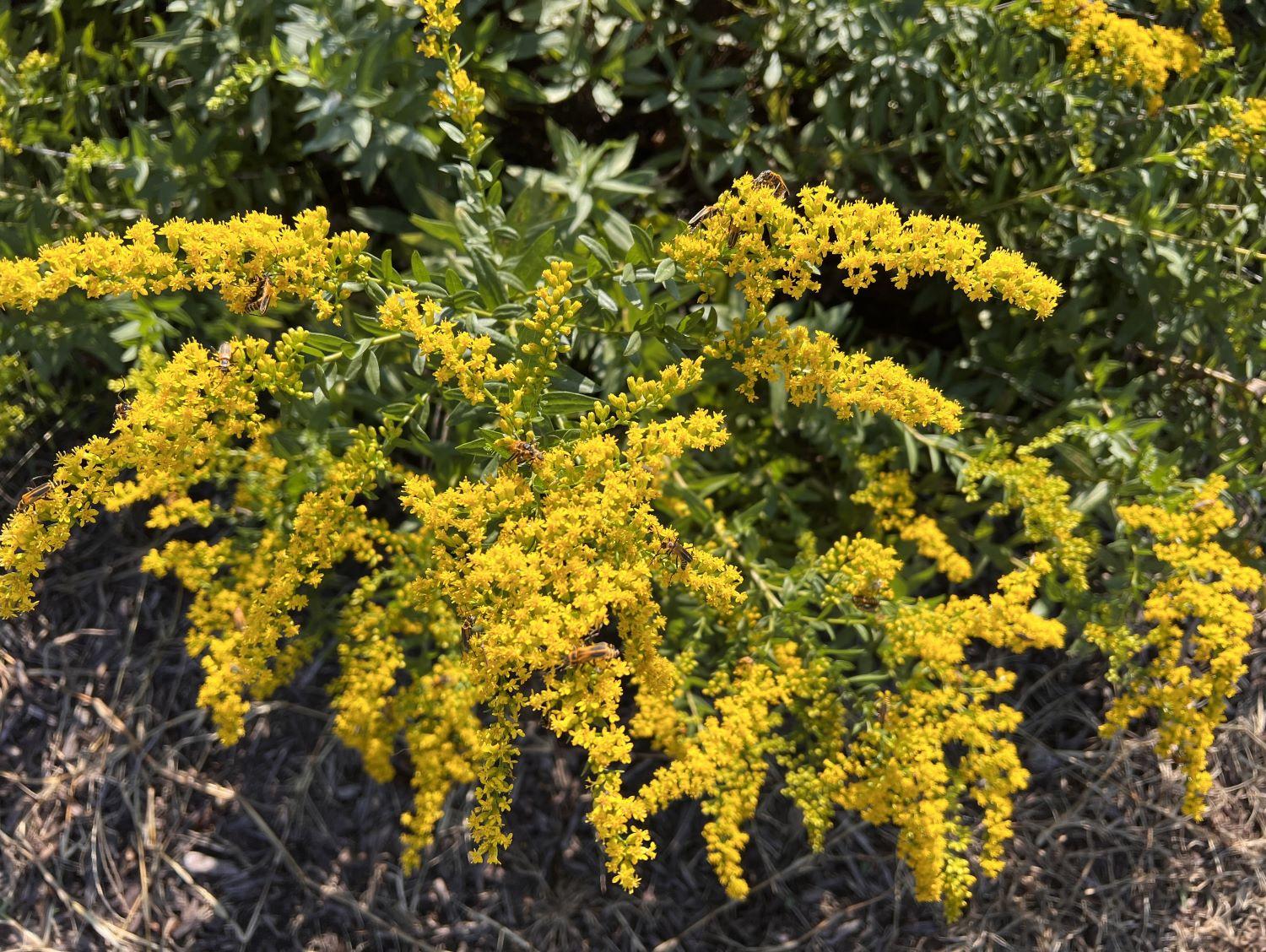
Solidago rugosa 'Fireworks' goldenrod in bloom. Photo: G. Rosenkranz, UME
Sustainable Gardening
- Fallen leaves are beneficial for your garden and the environment. As the leaf pieces decompose, they will add nutrients and organic matter to your soil. Move leaves to a back or side area of the yard, leave them underneath trees and shrubs, or put them in a compost bin.
- Trees have so many benefits! They provide shading, cooling, wildlife habitat, carbon storage, and stormwater absorption. Maryland is aiming to plant 5 million native trees by 2031. Plant your own tree, volunteer to care for one, or support forest conservation. Be a tree steward!
Trees & Shrubs
- Flower buds are forming or are already formed on spring-flowering shrubs. To prevent reducing next year’s bloom, don’t prune spring-flowering shrubs like azaleas and rhododendrons until after they bloom next spring.
- Nursery stock trees and shrubs can be planted until the ground freezes. Carefully examine trees and shrubs prior to purchase to assess quality. With balled and burlap stock cut the twine around the ball and cut away the nylon or burlap wrapping.
- Never carry a tree by its trunk, this can damage the roots. Instead, always carry them by their root ball or by the container.
- Fall coloration on white pines happens every fall but in some years it is more noticeable. The inner needles turn yellow and drop off. This can also occur on rhododendrons and other evergreen shrubs. This is normal for this time of year
Compost
- Start a compost pile by mixing together spent plants, kitchen scraps, fallen leaves, old mulch, and grass clippings. Shred your materials with a lawnmower, string trimmer, or machete to speed up the breakdown process. Keep twigs, branches, and other woody materials out of the pile.
Edible plants
- Full-size green tomatoes can be picked before a frost and brought indoors to ripen. They ripen more quickly if placed in a paper bag with a banana or apple. The ethylene gas released from the fruit will help to ripen the tomatoes.
- Carrots can be over-wintered in the garden by covering the bed with a deep straw or leaf mulch. Pull carrots through the winter as needed.
- Lettuce, spinach, arugula, and kale can be planted through the middle of the month. Cover these late plantings with a cold frame, temporary greenhouse, or row cover. Be sure to fertilize seedbeds, keep the soil moist, and protect seedlings from pests. The young plants will go dormant and re-grow in spring.
- Discard badly diseased plants and fruits; don’t till them back into the soil. All other plant waste can be hot composted.
Flowers
- Goldenrods and asters are important fall flowers for pollinators. Consider adding one or more of these to your garden. There are many species and cultivars available.
- Save seeds from annual and perennial flowering plants like zinnias, cosmos, celosia, and butterfly weed to be planted next spring.
- Geraniums can be overwintered in several ways. Entire plants can be brought inside and grown in a sunny window, or cuttings can be taken from existing plants. Cuttings from other annuals like begonias, salvias, and coleus also root well.
- Daffodil bulbs, alliums, and other spring-flowering bulbs can be planted now. Plant them in a sunny spot, in well-drained soil. Tulip bulbs should be planted from mid-October through November to prevent them from sprouting prematurely.
Lawns
- Time is running out for lawn renovation or overseeding. Grass seed should be planted by the middle of the month.
- There is still time to apply fertilizer on your lawn. Look for a fertilizer with 0 phosphorus. Apply according to the University of MD Extension lawn fertilization schedule. Fertilizer needs to be applied before November 15th to comply with the Maryland Department of Agriculture lawn fertilizer law.
Wildlife
- Stop feeding your fish in outdoor ponds. They cannot metabolize food easily during cold weather.
- Black rat snakes may still be hatching in October. These harmless baby snakes are not black at hatching but are a light gray with dark brown rectangular markings down the back.
- Feeding deer is not recommended. The practice upsets the size of the local herd, increases their tendency to become pests, and may contribute to the spread of disease within their population.
Diseases
- In the cooler, sometimes wetter fall weather harmless toadstools and other mushrooms may be plentiful around tree root systems. However, destructive wood-rotting organisms produce conks on tree trunks. Affected trees may be suffering from extensive wood decay and should be inspected for trunk soundness by a licensed arborist.
Indoor plants and pests
Indoor plants
- Inspect new indoor plants before purchase. Choose plants that appear to be free of insects and disease, have new leaf or flower buds, and healthy foliage. Slipping the plant out of its container to look at the roots is recommended. Roots should be white or tan, fleshy (not brown and crumbly), be able to hold the soil together but not root-bound.
Pests
- Many different spiders like jumping spiders, yellow house spiders, wolf spiders may enter homes. They can wander indoors through or around windows, doors, and cracks. Caulk cracks and tighten up around doors and windows, especially those at ground level. Most spiders are shy and harmless to humans. Normally, they will not attempt to bite unless accidentally trapped or held. They are beneficial by feeding on nuisance insects. Killing spiders should be avoided, if possible.
- Drain flies are found primarily in rooms or areas where there are drains such as kitchens, basements near floor drains, etc. Drain flies are small, 1/16 to 1/4 inch long, delicate and fuzzy. Their fuzzy wings make them easy to identify.